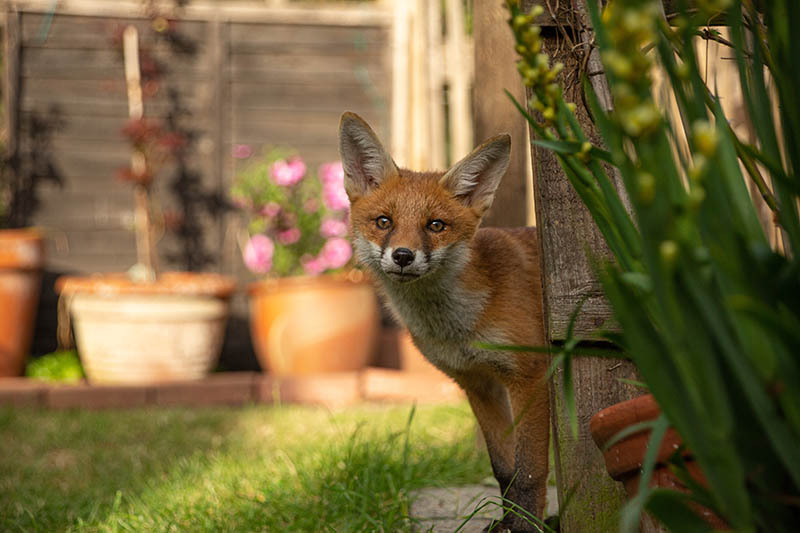How to Get Rid of Foxes in Your Yard (6 Effective Ways)
-
Pete Ortiz
- Last updated:

Compared to other animals, foxes are relatively more intelligent. So intelligent that they are capable of scoring as high as a human child on an IQ test. What’s more, some researchers believe that they were the first animals to learn how to use the planet’s magnetic fields when trying to gauge distance or get a sense of direction.
Are they aggressive towards humans? No. They mostly prey on smaller species, thus highly unlikely to attack you without any reason. If they keep paying you a visit, it’s probably because your yard is infested by rodents that they like to prey on.
But how do you rid your yard of foxes? Well, that’s the million-dollar question that we’re here to answer. The following tips might come in handy.
The 6 Effective Ways of Getting Rid of Foxes in Your Yard
1. Install Motion-Activated Lights Around the Yard

Foxes are nocturnal in nature. They hate lights so much that you’ll find them resting during the day, patiently waiting for darkness to fall upon us. If your yard is always well-lit up, they’ll likely never come close.
Procuring a sensitive motion sensor light shouldn’t be an issue, as they are sold literally everywhere.
Motion-activated lights are way better than the conventional kind since they save energy. Your energy bills will also drop significantly because they won’t be on the entire time. The only disadvantage is that they tend to have a shortened lifespan. We suspect that this could be due to the frequent switching.
To get the job done, you have to install the lights in areas most frequented by the fox. Fix them next to the flowerbeds, near the trash cans, and in areas most likely to be infested by rodents.
2. Fence Your Yard
Fences are meant to protect insiders by deterring outsiders from ever entering without permission. Therefore, it’s time to invest in a good fence that will leave zero spaces or gaps once installed.
If there’s even a tiny gap left, the fox will see that as an invitation to get in and out, whenever it’s hunting for food. They sometimes get so desperate—especially if they are certain that there’s food waiting for them on the other side—that they dig their own entry and exit points.
To prevent that from ever happening, you should use concrete as the foundation. Or, if procuring concrete on such short notice is a problem, just bend the bottom section of that fence to make it look like a hook before burying it. The fence should be at least 4 feet high since these animals are known to jump up to 3 feet high.
Consult a PEST-CONTROL expert
Find a pest-control specialist in your area, and get free, no-commitment estimates for your project.

3. Install Sprinklers

Motion-activated sprinklers are an incredible investment if the goal is to discourage pests from encroaching. Foxes have the same attitude towards water as cats. They don’t like getting wet if they don’t have to.
Motion-activated sprinklers are not difficult to install or use. However, you’ll have to uninstall and reinstall them in different areas of the yard every couple of days, as the foxes could use their intellect to figure out where they are situated.
4. Clean Your Yard
Foxes are very similar to coyotes in the sense that they like to hang around in small family groups. So, if you’ve spotted one scouting your yard, its family is not so far behind. You need to clear your yard to encourage the rodents to build homes elsewhere. And seeing as foxes love spending time in areas that are sheltered or shaded, you also have to keep the grass short.
Your trash cans or bins should not be accessible to intruders. Foxes love overturning trash cans searching for scraps that you might have left behind. And speaking of scraps, don’t forget to clear up the bird feeders once the birds are done eating.
5. Install Prickle Strips

These weather-proof plastic meshes have always been effective when it comes to dealing with the problem of digging foxes. Particularly if you’re looking to protect your vegetable patches, potted plants, or flowerbeds. They are also pocket-friendly, very durable, and can be used to deter other animals as well.
Are prickle strips hazardous to animals? No. This product will inflict some degree of pain, but the injury won’t be life-threatening. The installation process is not time-consuming, as it only involves digging out a shallow depression in the ground, placing them with the spikes facing upwards, and then covering the rest of the parts with soil.
6. Set Up an Ultrasonic Fox Repellent
These devices have been designed to emit sound at a frequency that our ears cannot detect or process. They come in different iterations, some having flashing lights that could also prove to be instrumental in scaring away the foxes. To reduce the cost of operation, you could work with solar-powered repellents instead of traditional models. But we’re obligated to let you know the mains-powered variants are comparatively more effective.
Frequently Asked Questions

What Type of Scent Do Foxes Hate?
This species has a powerful sense of smell. But that’s to be expected, seeing as they belong to the Canidae family. The same family as the coyotes, wolves, jackals, and “man’s best friend,” the dog.
We noted that foxes hate the smell of garlic and chili peppers. So, you can DIY a repellent by mixing both ingredients with water to keep them away. Use a spray bottle to effectively spread it around the yard, but don’t forget to test it first on a small area.
Can Foxes Spread Rabies?
This is not something that’s unheard of. Even though the probability of that happening is lower compared to that of a skunk, raccoon, bat, and even a dog, it’s still very much possible. So, if you suspect that your dog or cat has been bitten by a fox, don’t wait for the symptoms to start showing—go see a vet immediately.
How Do You Know if There’s a Fox in the Vicinity?
Like most animals, foxes love marking their territories. So, they’ll intentionally leave droppings in prominent areas to send a message. You might wake up one morning and find strange-looking droppings in the middle of the yard.
They also like to leave behind a musky smell and a trail of destruction. Your trash cans will be upended, the crops damaged, and the flowerbeds destroyed. They are drawn to flowers because they know insects are also attracted to flowers. And insects are rich in protein, which is an essential macronutrient.
Conclusion
It won’t be easy to spot a fox during the day, as they are nocturnal creatures. A few of them have been caught venturing before the close of the day, only because they were starving and couldn’t wait. If you’d like to get rid of them, clean out and fence the yard. If that doesn’t work, explore all the other options we mentioned above.
Featured Image Credit: Chedko, Shutterstock
Contents


